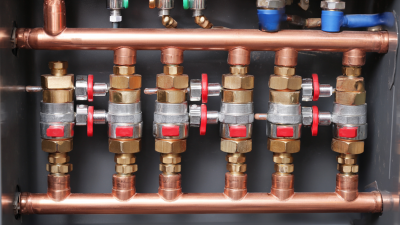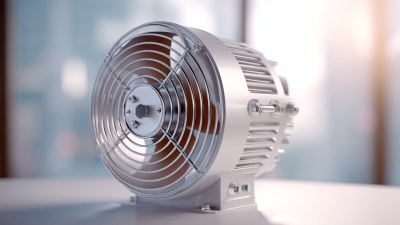




In the HVAC industry, the importance of selecting the right condenser fan cannot be overstated, especially considering that fans account for up to 15% of total energy use in commercial cooling applications, as highlighted by the U.S. Department of Energy. An efficient condenser fan is crucial for maintaining optimal airflow and ensuring that the refrigeration system operates at peak efficiency.

Recent studies indicate that upgrading to a high-efficiency condenser fan can reduce energy consumption by as much as 20%, leading not only to significant cost savings but also enhanced system longevity. With the increasing emphasis on energy conservation and sustainability, this ultimate checklist will guide you through the essential factors to consider when choosing a condenser fan to maximize performance while minimizing environmental impact.
In HVAC systems, condenser fans play a crucial role in maintaining optimal efficiency and performance. These fans are essential in the heat exchange process, as they help dissipate the heat absorbed by the refrigerant. When the refrigerant flows through the condenser, it releases heat into the surrounding air, and the efficiency of this process heavily relies on the condenser fan's performance. A well-functioning fan not only enhances heat transfer but also ensures the entire HVAC system operates smoothly, resulting in energy savings and prolonged equipment life.
Understanding the importance of condenser fans extends beyond mere functionality. Selecting the right fan can significantly impact the overall energy efficiency of an HVAC system. Factors such as airflow, noise levels, and durability should be considered carefully. An appropriately sized fan can reduce energy consumption and lower electricity bills, while also contributing to a more comfortable indoor environment.
Moreover, regular maintenance of condenser fans is vital to ensuring their optimal performance, thereby safeguarding the efficiency of the entire HVAC system. By prioritizing the selection and upkeep of condenser fans, homeowners and facility managers can achieve substantial gains in efficiency and cost-effectiveness.
When selecting a condenser fan, several key factors can significantly impact its efficiency and performance. First, consider the fan's airflow capacity, measured in cubic feet per minute (CFM). According to the American Society of Heating, Refrigerating and Air-Conditioning Engineers (ASHRAE), an optimal airflow rate is essential for maximizing heat exchange efficiency in condensers. Aim for a fan that provides a balance between adequate airflow and energy consumption.
Another critical aspect is the fan's static pressure rating. High static pressure ensures that the fan can effectively push air through the condenser coil, maintaining optimal cooling performance. A study by the Engineering Society of America indicates that fans operating at their recommended static pressure can enhance overall system efficiency by up to 15%.
**Tips:** Always check the fan's energy efficiency rating. Fans with high-efficiency ratings not only consume less power but also contribute to reduced operational costs. Additionally, consider noise levels since quieter fans can improve workplace comfort without sacrificing performance. Lastly, ensure that the fan's dimensions fit your condenser's specifications to avoid installation issues down the line.
When selecting the right condenser fan for optimal efficiency, understanding key features that enhance its performance is essential. A recent assessment reveals that energy-efficient systems, particularly those with inverter technology, leverage variable speed operations to significantly lower power consumption while optimizing cooling output. This is crucial as condensers play a pivotal role in maintaining the overall energy efficiency of HVAC systems.
Moreover, modern condenser fans with integrated sensors can automatically adjust their speed according to the room's temperature, ensuring that your system operates only as needed. According to industry reports, such intelligent features can enhance energy savings by up to 30%. Additionally, choosing a fan made with high-quality materials such as corrosion-resistant coatings further guarantees longevity and reduced maintenance costs, aligning with the growing trend of sustainable living practices.
Lastly, the selection of the right size and design of the condenser fan impacts airflow dynamics, leading to an improved cooling experience. Reports indicate that proper sizing can lead to a 15-20% enhancement in the system's overall efficiency. By focusing on these features, consumers can ensure they select a condenser fan that not only meets their cooling needs but also optimizes energy efficiency in the long run.
| Feature | Description | Impact on Efficiency |
|---|---|---|
| Blade Design | The shape and pitch of the blades affect airflow and pressure. | Improves airflow, which enhances cooling efficiency. |
| Motor Efficiency | High-efficiency motors reduce energy consumption. | Lowers operational costs and enhances performance. |
| Variable Speed Control | Allows the fan speed to adjust based on cooling needs. | Enhances energy efficiency by using power only as needed. |
| Size and Capacity | Matching the fan size with the condenser capacity is crucial. | Prevents overworking the system, maintaining efficiency. |
| Durability | Materials resistant to corrosion and wear extend the fan's lifespan. | Ensures consistent performance over time, optimizing efficiency. |
When selecting the ideal condenser fan for your cooling system, it's essential to compare various fan types to ensure optimal performance. The primary types of condenser fans available include axial fans, centrifugal fans, and mixed-flow fans, each with distinct characteristics and applications.
 Axial fans are known for their high efficiency and ability to move large volumes of air at lower pressures, making them a popular choice for residential and light commercial applications. On the other hand, centrifugal fans excel in high-pressure environments and are commonly used in larger industrial settings where airflow resistance is a concern.
Axial fans are known for their high efficiency and ability to move large volumes of air at lower pressures, making them a popular choice for residential and light commercial applications. On the other hand, centrifugal fans excel in high-pressure environments and are commonly used in larger industrial settings where airflow resistance is a concern.
Another critical factor to consider is the fan's motor type. Electronically Commutated Motors (ECMs) offer superior energy efficiency compared to traditional induction motors, as they can adjust their speed and power consumption based on the system's needs. Additionally, evaluating the noise level produced by different fan types is crucial, particularly for residential installations. Quiet operation not only enhances comfort but can also be a determining factor in local regulations regarding permissible noise levels. By carefully assessing these factors, you can choose a condenser fan that not only meets your performance requirements but also contributes to overall system efficiency and long-term savings.
When it comes to prolonging the life of your condenser fan, regular maintenance is essential. The fan plays a crucial role in efficiently cooling your system, and neglect can lead to costly repairs or replacements. One of the first tips is to ensure that the fan is clean. Dust and debris can build up over time, blocking airflow and forcing the unit to work harder.









